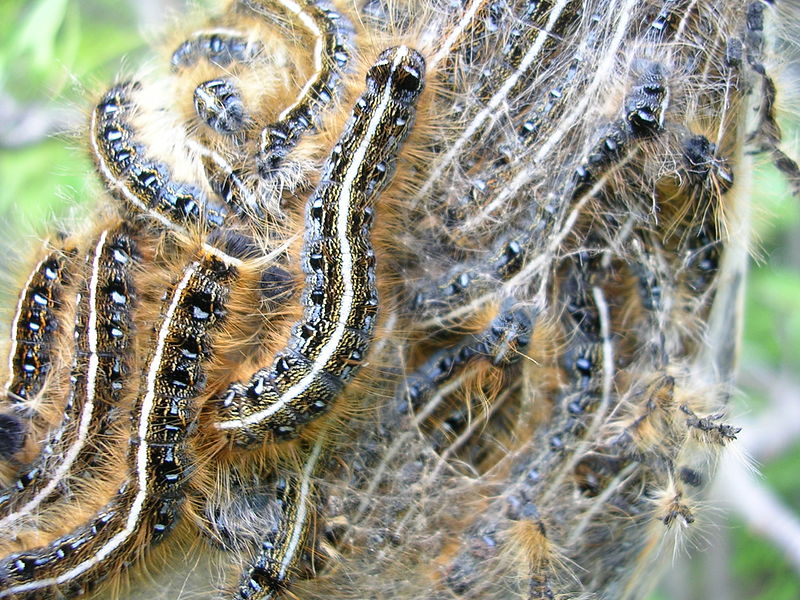
I have long known of two true pests that not only damage trees, but destroy their beauty. While the fall webworm is one of these pests, what I would like to do now is to interview the other. He is an eastern tent caterpillar. He and his family are, at the moment, engaged in their dirty work.
The Interview
Vince: It’s the middle of April, and I see you’re already pretty good-sized and busy at work. How do you start out?
TC: Well, not many people know it, but our tiny egg pouches can be found laid along the branches where our nests will appear. A great example of an egg pouch is seen in this Michigan State University photo. It’s a good thing humans are not aware of it or they might peel the pouches and squash our eggs this fall!
Vince: You’re right, that is a nice photo. Hm.
TC: Once we’ve hatched, we quickly go to spinning our tents. We are always laying thread, wherever we go. Of course, we travel a little more boldly as we increase in size. We prefer to travel along the tops of the branches. Perhaps you have seen straight white pathways along the limbs?
Yes, I see you have, from the photo you’ve included here. At times, to inform the ‘pillars of the community, we mark our trail using the chemical attractants you humans call pheromones. You see, unlike humans, we like to share.
Vince: Yes, this is the first year I’ve noticed the trails. Reminds me of the song, “Happy Trails to You…” But, say… I’ve noticed your tents increase in size with time. And I’ve noticed that if a part of a tent is in the sun more directly, it appears to have a thicker wall. Why is that?
TC: Well, we grow and need more space. As to why the side of a tent in the sun receives thicker spinning, I’ll let you guess about that. Is it because we enjoy the sun but don’t want too much of a good thing?
Eventually—oh, after 4 to 6 weeks—we leave the nest and the tree to form cocoons. This helps us prepare for our turning into moths. Sadly, it is also a time when you humans are only too happy to kill us.
Vince: Well the eastern tent caterpillar does defoliate our best trees. Sometimes it seems you want to strip all the leaves off our beautiful trees.
TC: Well, you’ve got to remember, we get hungry, too. Besides, the leaves do eventually grow back.
Vince: Well, sure, but sometimes our trees suffer setbacks for quite a long time! Now forgive me, dear TC, but I must be outspoken about this. We humans love beautiful butterflies and are willing to put up with some shenanigans in order to enjoy them. But, let’s face it, tent caterpillars are one of Earth’s ugly ducklings.
TC: Well, beauty is in the eye of the beholder. I’ve seen a few cute numbers in my day. I’m only saying…
Vince: At any rate, thank you for the interview. Now I must spew a few facts and figures to my readers. It’s at this time I must say, “Please forgive me for this…” SPLAT!
MRLS
OK. Odd as it may seem, female horses… yes, mares… suffer from what has been called mare reproductive loss syndrome (MRLS). A horse fetus may be aborted through of all things, exposure to our buddy the eastern tent caterpillar! This was first noted in the state of Kentucky (naturally). But I’m happy to say, a combination of long chain diene-aldehyde and diene-alcohol compounds has proved effective in trapping the moths.
Chemicals of this or a related sort are not rare in nature. In fact, the stinkbug, famous for its bad smell, is a chemist that specializes in such foul-smelling chemicals as trans-2-decenal and trans-2-octenal.
Oddly Enough
Oddly enough, when one grabs a caterpillar tent in his hand and squeezes it (with its contents of caterpillars and, um, pooh), then throws it on the ground and stomps on it thoroughly, he may then look at his hand and not notice any mess on it. Strange, indeed. Perhaps the silk keeps the mess from a person’s hand. Of course, it is a good practice when going indoors to wash the hands well.
Eastern Tent Caterpillar Silk Chemistry
The exact chemistry of the eastern tent caterpillar’s silk is unknown, but it is considered likely it is similar to that of so-called related species. Such silk is made up of 73% fibroin (insoluble protein), 22% sericin (a gum made up of soluble glycoproteins). The rest may be wax and inorganic components. The caterpillar cannot control the output of its silk. Apparently it forcibly breaks or bites off a strand.
In Conclusion
In conclusion, it is undoubtedly to the best advantage that the way to minimize your negative experience with the eastern tent caterpillar is to take steps in the fall to remove and crush egg casings. Then, in early spring, keep an eye out for tents in trees. Clean them out and crush them. If you can’t get to some of them because an infested tree is particularly large, take a pole and destroy them. Hopefully you will suffer less, the next year. But don’t count on it. Keep in mind next fall is coming.
Note: You might also enjoy Spring Webworms, Fall Webworms – What’s the Difference?
References:
- Appleman: Tent Caterpillars
- Plant Management Network: Pesky Tent Caterpillars Emerging
- AlChE: ChEnected: What Stinks?
- The Tent Caterpillars by Terence D. Fitzgerald, 1995.
- Textiletoday: Sericin